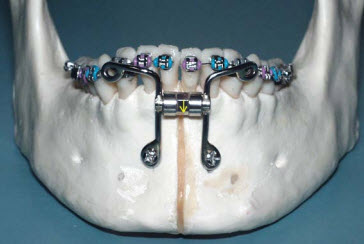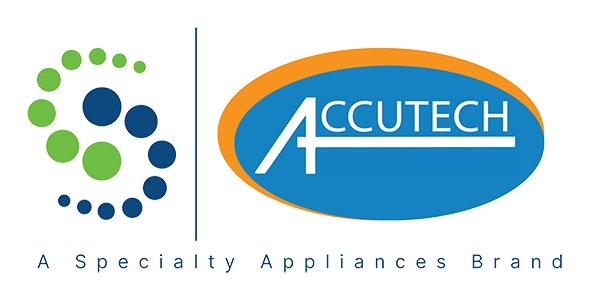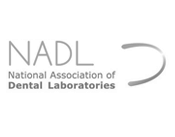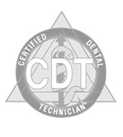We appreciate your timely manner with our appliances. Very helpful staff if and when questions arise.
Appliances delivered on time every time or they're FREE.
1-800-734-7855

Dental expansion of the mandibular arch beyond the existing width between the canines is thought to be unstable and prone to relapse. Faced with this dilemma, Dr. John King wanted a more reliable method of treating narrow mandibular arches. One that would produce stable results without compromising the patient’s potential for a more broad and beautiful smile. This led to his interest in distraction osteogenesis and the development of the Distrax appliance.
Distraction osteogenesis is a surgical technique where a bone cut is made in a preselected site. This procedure is called an osteotomy. A fixed device is then placed spanning the two sides of the osteotomy. This device is expanded in controlled increments until the desired size is achieved. New bone forms in the gap and the increased size becomes permanent. By using this procedure, bone length or width can be increased as well as the volume of the surrounding tissue.
The original technique was pioneered in the 1950s by Russian orthopedic surgeon Gavril Ilizarov who used it to treat orthopedic limb deformities. Dr. Ilizarov practiced in a remote Siberian village with limited equipment and resources. While preparing a patient for a bone graft, he attempted to widen a surgically created gap with a fixed device intending to graft bone in the site. However, he found that under the tension of the fixed device, new bone formed eliminating the need for the graft. This discovery led him to the development of a procedure for the lengthening of the long bones of the arms and legs using a fixed external framework which was attached to the bones with pins. His work continued for the next four decades and laid the groundwork for modern distraction osteogenesis procedures.
In the early 1990s the principles of D.O. were successfully used to lengthen underdeveloped mandibles and an interest in the dental applications for D.O. began to grow. As an orthodontist, Dr. King was interested in developing a method for the permanent expansion of the mandible that would produce stable results and decided to design a distraction device for this purpose. In order to make his distraction device more user friendly for both the oral surgeon and the patient, he designed a custom-fit laboratory fabricated appliance based on the Super Screw appliance. Dr. King had used the Super Screw in his practice for Rapid Maxillary Expansion and found that parents preferred the wrench-activated design. The distraction appliances available at the time were either kits that required the oral surgeon to customize the appliance chairside while operating on the patient or tooth-borne appliances. Working with technicians at Accutech Orthodontic Lab, Dr. King found that it was possible to custom fabricate a hybrid appliance for the individual patient thereby saving the oral surgeon the difficulty of making major adjustments during the surgical procedure and avoiding the problems associated with tooth- borne appliances.
Tooth-borne appliances are those distraction devices which are attached entirely to the patient’s teeth. This causes all of the lateral forces of the appliance to be placed on the superior portion of the mandible resulting in a V-shaped opening with most of the expansion in the alveolar (dental) region and very little expansion in the basal bone of the inferior region. This type of result is thought to be less stable and prone to relapse. The hybrid design of the Distrax is both tooth-borne and bone- borne with the inferior portion fastened to the mandible and the superior portion fastened to the cuspids. This design has been proven to produce a more parallel opening and resulting bone regenerate which is considered to provide greater stability.
With this design, Dr. King has successfully treated over 50 patients with narrow mandibular arches without extracting healthy teeth. Patients choosing this treatment method are referred to an oral surgeon for an outpatient procedure known as a mid-symphyseal osteotomy. During this procedure, the surgeon creates a vertical osteotomy in the mandible at a preselected site (usually between the central incisors) and places a custom fit Distrax appliance. The inferior loops of the appliance are fastened to the mandible with bone screws located below the root tips of the lateral incisors and the superior loops are ligated to brackets located on the cuspids. A light cured resin is then used to attach the superior loops to the brackets and the circumdental wire for added retention.
Following a latency period of five to seven days, the distraction phase begins. It is important to begin activation of the Distrax at this time as new bone growth will begin and a bony union may form if distraction is delayed. The patient is instructed to make two .5mm activations of the Distrax per day. The standard protocol for most patients is to distract at a rate of one mm per day. The Super Screw comes with an arrow imprinted on the body of the screw indicating the direction for the turns. When the Distrax is placed, this arrow is facing out. The lab has engraved a dot on the back of the screw 180 degrees from the arrow. This is designed to aid the patient in making the proper amount of activation each time. Following the first turn, the dot should be facing out and following the second turn the arrow has come 360 degrees around and should be facing out. After each activation either the arrow or the dot should be visible.
Orthodontic detailing can begin following the consolidation period. The additional space created by the distraction process can now be utilized to alleviate crowding and align the mandibular arch.
For more of Daryl's Lessons From The Lab please subscribe to our newsletter! Get Newsletter!

We appreciate your timely manner with our appliances. Very helpful staff if and when questions arise.
©2023 Accutech Orthodontic Lab, Inc.
Site Map | Terms & Conditions
Accutech Orthodontic Lab, Inc.
3345 Bridge Road, Suite 904
Suffolk, VA 23435 | Fax: 757.488.7340
| Fax: 757.488.7340




